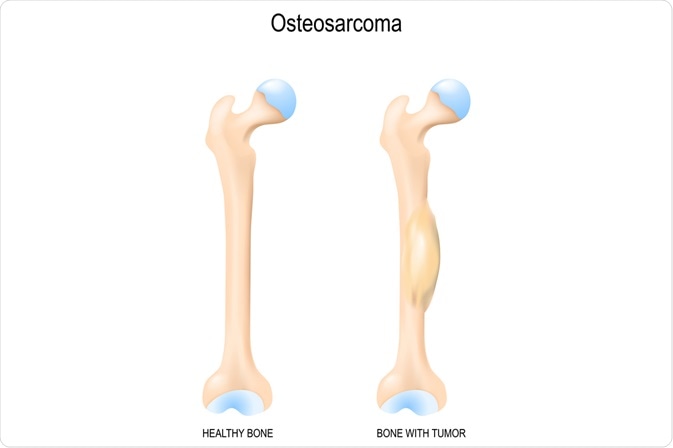Osteosarcoma is the most common type of cancer affecting the bone and involves abnormal osteoblast cells that are responsible for the construction of the bone.
Children and young adults are most likely to be diagnosed with the disease, particularly around adolescent growth spurts that occur during puberty when the bones grow more quickly.

Image Credit: Designua / Shutterstock.com
Epidemiology
The overall incidence of osteosarcoma in the United States is 400 cases per year, which equates to approximately 1 per 800,000 people. Individuals with darker skin have a slightly higher risk of being affected by osteosarcoma, with males being more likely to be affected by the condition as compared to females.
The disease is very rare in young children; however, the incidence increases dramatically when individuals reach growth spurts related to adolescence. The peak incidence of osteosarcoma occurs between the ages of 15 and 19, with 8.5 cases per million per year.
Of those patients who are diagnosed with the disease, the five-year survival rate is approximately 63%, with a more positive prognosis noted in females than males.
Signs and symptoms
The majority of tumors develop in the distal femur or the proximal tibia, both of which are bones located near the knee. Another common site of osteosarcoma is the proximal humerus, which is the long bone in the arm that is closest to the shoulder. While the incidence of osteosarcoma in these bones is notable, it can arise in any bone in the body.
Most patients experience signs of the disease for several weeks or months before they seek medical advice. The most common symptom is pain, which becomes more evident with physical activity. Due to the non-specificity of the symptoms, individuals often think the pain may be due to growing or previous physical trauma.
Upon physical examination, specific symptoms that may be noted in patients with osteosarcoma include a mass around the tumor site that may be tender or warm and decreased range of motion of affected joint.
There may be involvement of the lymph node and respiratory system in more advanced cases, but this is not seen in the majority of cases.
Telangiectatic is a specific subtype of osteosarcoma that is usually linked to a pathologic bone fracture. The pain and possible swelling in the area may cause difficulty of movement, leading to a limping gait.
Subtypes
Cases of osteosarcoma can be classified according to their appearance on an X-ray image or microscopic evaluation. The different subtypes, which include high-grade, intermediate-grade, and low-grade osteosarcoma, provide valuable information about the prognosis of the condition.
High-grade osteosarcomas are the fastest-growing type and are associated with a poorer prognosis. Their appearance under a microscope is distinct from that of normal bone cells, due to the quickly dividing cells. There are several subtypes of high-grade osteosarcomas, including:
- Osteoblastic
- Chrondroblastic
- Extra-skeletal
- Fibroblastic
- Juxtacortical high grade
- Pagetoid
- Post-radiation
- Small cell
- Telangiectatic
Intermediate-grade osteosarcomas are the least common type and exist between low and high-grade in severity. Juxtocortical intermediate grade is one subtype of this grade.
Low-grade osteosarcomas are associated with the most positive prognosis and grow slowly in comparison to the other grades of osteosarcoma. When viewed under a microscope, the cells of this type of osteosarcoma appear similar to normal bone cells and have few cells undergoing replication. Subtypes of this grade include juxtacortical low-grade and intramedullary well differentiated.
References
Further Reading